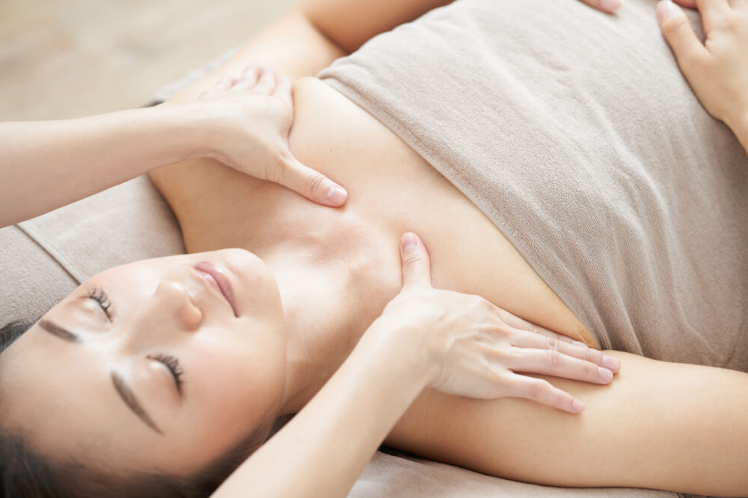Breastfeeding is a beautiful and natural process. However, it’s not always as easy as it seems. However, some lactating mothers may have engorgement, clogged glands, or mastitis which are not comfortable or painful. Accordingly, they may also make breastfeeding painful to the mother. The technique of breast massages humanizes the mentioned turmoil.
In this thorough guide, we’ll scrutinize breast massage and will look into its advantages. After that, we will give steps on how to do breast massage. In addition to that, we’ll look into breast massage, paying special attention to lymphatic breast massage, and its importance for lactation.
What is Breast Massage
Breast massage is the breast massage or lactation massage that helps to achieve better and effortless female breastfeeding. It is based on doing the same massage normally used on the breast to allow the milk to flow freely without obstruction. This approach may prove helpful for lactating females in tackling regular breastfeeding difficulties and launching an effective breastfeeding regime.
Primary Purpose of Breast Massage for Breastfeeding
The main aim of breast massage during breastfeeding is to facilitate effective lactation. This technique can be particularly beneficial when the breast milk first “comes in,” where the risk of engorgement is high. In addition, it can alleviate pain or discomfort in the breast between feedings and help prevent or treat mastitis, an infection of the milk ducts.
Some of Breast Massage Benefits
Breast massage not only aids in resolving or preventing potential lactation issues, but it also offers several other benefits. Let’s delve into some of these breast massage benefits:
1. Prevents and Manages Clogged Milk Ducts and Breast Infections
Regular breast massage can help prevent and manage clogged milk ducts and breast infections. By massaging a clogged duct or another hardened part of the breast, you can relieve pain and loosen the clog by breaking up the milk in the impacted area.
2. Increases Milk Production
Breast massage can stimulate lymphatic and blood circulation, which helps clear blocked milk ducts and enhance breast milk supply. This breast massage technique is especially beneficial for parents who pump beyond the newborn phase, where changes to the breastfeeding schedule can contribute to a decrease in milk supply.
3. Improves the Overall “Transfer” of Milk
Breast massage can also assist in the overall “transfer” of milk, i.e., the process of getting milk from your breast to your baby. It can be particularly helpful for babies with feeding issues, such as those who are sleepy or sluggish at the breast or who have trouble latching onto or emptying the breast during nursing sessions.
4. Promotes Relaxation and Healing
Just like massaging sore muscles, massaging breast tissue promotes relaxation and healing. This practice can make breastfeeding a more comfortable and enjoyable experience for nursing mothers.
How to Massage Breast for Tightening and Breastfeeding
Now that we understand the significance of breast massage, let’s move on to the practical part – how to massage breast for tightening and breastfeeding. Here’s a simple step-by-step guide:
- Start with a Warm Shower: A warm shower can help increase blood flow to the breasts, making them more responsive to the massage.
- Get Comfortable: Sit back and get into a comfortable position. You can perform the massage on one breast while your baby nurses on the other, switching halfway through.
- Apply Oil: Dab a little extra virgin olive oil onto your fingers to reduce friction and enhance the massage experience.
- Massage the Areolas: Start by massaging your areolas with your fingertips in small, circular motions.
- Massage the Entire Breast: Continue massaging in small circles all over your breast. Include some soft fingertip tapping now and then.
- Use the backside of your fists: Softly knead your breast using the backside of your fists.
- Hand Express Some Milk: Between massages, hand Express some milk. As your symptoms improve, you can lessen the amount of times you need to hand express.
- For Plugged Ducts: Use your free hand to gently push behind the plug to guide it down the afflicted duct so it can be released.
- For Engorgement and Mastitis: Massage long, horizontal movements starting from the breast to the armpit, and then massage going in the opposite direction.
- Be Gentle: Make sure to remain gentle during the massage. If you press too hard, you could cause minor tissue damage, and bruising is a common sign that a massage is being done too roughly.
Lymphatic Breast Massage
Lymphatic breast massage is a specific type of breast massage that focuses on improving lymphatic circulation in the breasts. The lymphatic system plays a crucial role in body health, including the health of the breasts. It helps to clear toxins and waste products from the body, including the breasts. A lymphatic breast massage can be particularly beneficial for nursing mothers as it can help prevent or alleviate issues like clogged ducts and mastitis.
To perform a lymphatic breast massage, use the same techniques as a regular breast massage but focus more on the areas around the armpit, where many lymph nodes are located. Remember to be gentle and avoid causing pain or discomfort.
Conclusion
Breast massage can be a potent tool in a nursing mother’s arsenal. It not only helps alleviate common breastfeeding issues but can also improve milk production and promote relaxation and healing. Remember to always be gentle during the massage and consult with a healthcare provider if you experience persistent issues.
For more information on breast massage or to explore a wide range of spa services that can enhance your overall wellness and relaxation, visit Spa Utopia. Our expert staff is there to lead you to various massage methods and is also present to assist you in getting the maximum results from the practice.
FAQ
1. What are the breast massage benefits?
Breast massage can help prevent and manage common breastfeeding issues like clogged milk ducts and mastitis. It can also increase milk production, improve the overall transfer of milk, and promote relaxation and healing.
2. How do I perform a breast massage for breastfeeding?
Start with a warm shower to increase blood flow to the breasts. Then, sit in a comfortable position and apply some oil to your fingers. Massage your areolas and the entire breast in small, circular motions, occasionally using the backside of your fists to knead your breast. Hand express some milk between massages and adjust your breast massage techniques based on whether you’re dealing with plugged ducts, engorgement, or mastitis.
3. What is a lymphatic breast massage?
A lymphatic breast massage is a specific type of breast massage that focuses on improving lymphatic circulation in the breasts. It can help clear toxins and waste products from the breasts, making it beneficial for nursing mothers.
4. How to massage breast for tightening?
The techniques used for a breast massage for breastfeeding can also be applied for breast tightening. Regular massage can help improve blood circulation and stimulate the tissues in the breast, leading to firmer and more toned breasts.
5. Can I perform a breast massage at home?
Yes, breast massage is simple to learn and can be done at home. However, if you’re uncomfortable with your technique or experiencing persistent issues, it’s recommended to consult with a certified lactation consultant or your healthcare provider.





